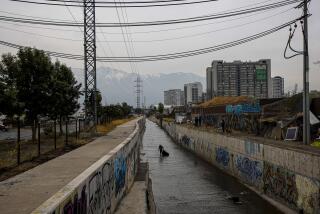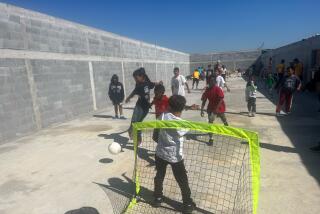Defeating Death Among Children of Chile : Medicine: Dr. Monckeberg has been at the forefront in bringing his nation’s infant mortality close to the rates of developed countries.
- Share via
SANTIAGO, Chile — Sundays at the cemetery, Fernando Monckeberg and his brothers would take turns counting the horse-drawn funeral carriages coming through the gate. There were always more white carriages than black ones.
“So whoever counted the most black carriages won,” Monckeberg recalls.
It was a game the boys played while waiting for their father, who was superintendent of the Santiago General Cemetery in the early 1930s. Monckeberg, 65, smiles at the memory, but he is making a somber point. Those numerous white carriages bore the bodies of babies and children.
“At that time, more than half of all deaths occurred before age 6,” he said.
When Monckeberg graduated from medical school in 1952, Chilean children were still dying in droves, victims of poverty’s squalor and hunger. Saving the children soon became young Dr. Monckeberg’s life work.
Four decades later, Chile is a Latin American leader in child nutrition and health. And while many Chileans have helped make that remarkable progress possible, Monckeberg is widely regarded as the one person who has done the most.
Two pioneering institutions founded and led by Monckeberg have helped lower infant mortality in Chile to rates near those of developed countries, as well as save millions of surviving children from lasting damage by malnutrition.
Monckeberg believes that the lessons of Chile’s experience could be crucial for other developing countries. He argues that to save itself from backwardness, a nation must save its children from hunger.
“The poverty of Latin America damages the individual and thus makes it impossible for him to become part of a productive society,” he said.
In the early 1950s, Monckeberg participated in a study of malnutrition and mental damage. The results indicated that more than two-thirds of Chile’s children age 6 and younger were undernourished and mentally stunted to some degree.
Today, about 8% are undernourished, but most only mildly so. The vast majority of young people joining the work force are now free of mental and physical handicaps caused by hunger.
“For the first time, we are at a stage where undamaged elements are being incorporated,” he said. “So real development is now possible.”
In 1974, Monckeberg set up a private foundation, the Corporation for Infant Nutrition, known as CONIN. Over the next three years, using $9 million in donated funds, CONIN built 33 centers for the treatment of undernourished babies.
Chile’s public health system, which has a large network of hospitals and clinics, refers babies to the CONIN centers and helps pay for their operation. Monckeberg estimates that the program’s intensive treatment, usually lasting three months per baby, has helped prevent nearly 2,000 infant deaths a year.
The most common causes of death in undernourished infants are acute diarrhea and bronchopneumonia. Last year, only about 200 Chilean babies died of those ailments.
At a recent ceremony, staff members and volunteer workers gathered in Santiago to celebrate the recuperation of 50,000 undernourished babies in CONIN centers since the program began. A highlight of the ceremony was the presentation of two 17-year-old students, a girl and a boy, who had been among CONIN’s first infant patients.
“Thanks to CONIN’s work, they turned out to be perfectly normal young people,” said Marta Julio, one of the volunteers who attended the ceremony. “It was very nice and quite touching. You can imagine the applause they received.”
The centers not only provide babies with proper nourishment and medical care but also give them physical therapy and mental stimulation to help them recover from backwardness caused by hunger and neglect. When possible, the babies’ mothers are encouraged to participate in the treatment.
If CONIN has been a major weapon in Chile’s fight against malnutrition and infant mortality, it is but one part of an extensive arsenal that dates back to 1962, when the government created the National Health Service. The service provides free medical care to any Chilean who needs it.
Its programs of prenatal and pediatric care usually help detect malnutrition in babies and children before it becomes severe. The government also uses the health service’s network of clinics to distribute free powdered milk and food supplements to mothers and preschool children.
In addition, government-sponsored family planning aid combats malnutrition in children by reducing the size of poor families. Chile’s population growth rate has declined from 2.9% a year in the mid-1960s to less than 1.5% today.
A group of pediatricians headed by Monckeberg at the University of Chile Medical School began conducting research and advising government administrations on child nutrition in the 1950s. The unit became the Institute of Nutrition and Food Technology in 1976.
It has created formulas for nourishing food supplements that are distributed by the National Health System, and it has planned a feeding program in which private contractors provide free breakfasts or lunches, or both, in public nursery and grade schools. The same unit gave birth to CONIN.
Monckeberg is president of both CONIN and the institute. The soft-spoken, pipe-smoking pediatrician is known for his creative thinking, his administrative skills and a flair for public drama. Through the years, his plodding work has produced impressive results.
His institute has trained hundreds of health professionals in nutrition and related fields, including dozens of people from other Latin American countries.
It designed a kitchen-washroom-bathroom module that has been built into 400,000 low-income homes to improve their basic sanitation.
It developed the idea for a system of public nursery schools in poor neighborhoods that now provides meals and preschool education for 130,000 children.
And Monckeberg’s work is reflected in the huge drop in Chile’s infant mortality rate (deaths before the age of 1 year) since the early 1950s, when it was among the highest in Latin America. The rate has fallen from more than 130 deaths per 1,000 live births then to under 16 per 1,000 today, according to the Health Ministry.
That is lower than the rate for any other Latin American country except Communist Cuba.
More to Read
Sign up for Essential California
The most important California stories and recommendations in your inbox every morning.
You may occasionally receive promotional content from the Los Angeles Times.










